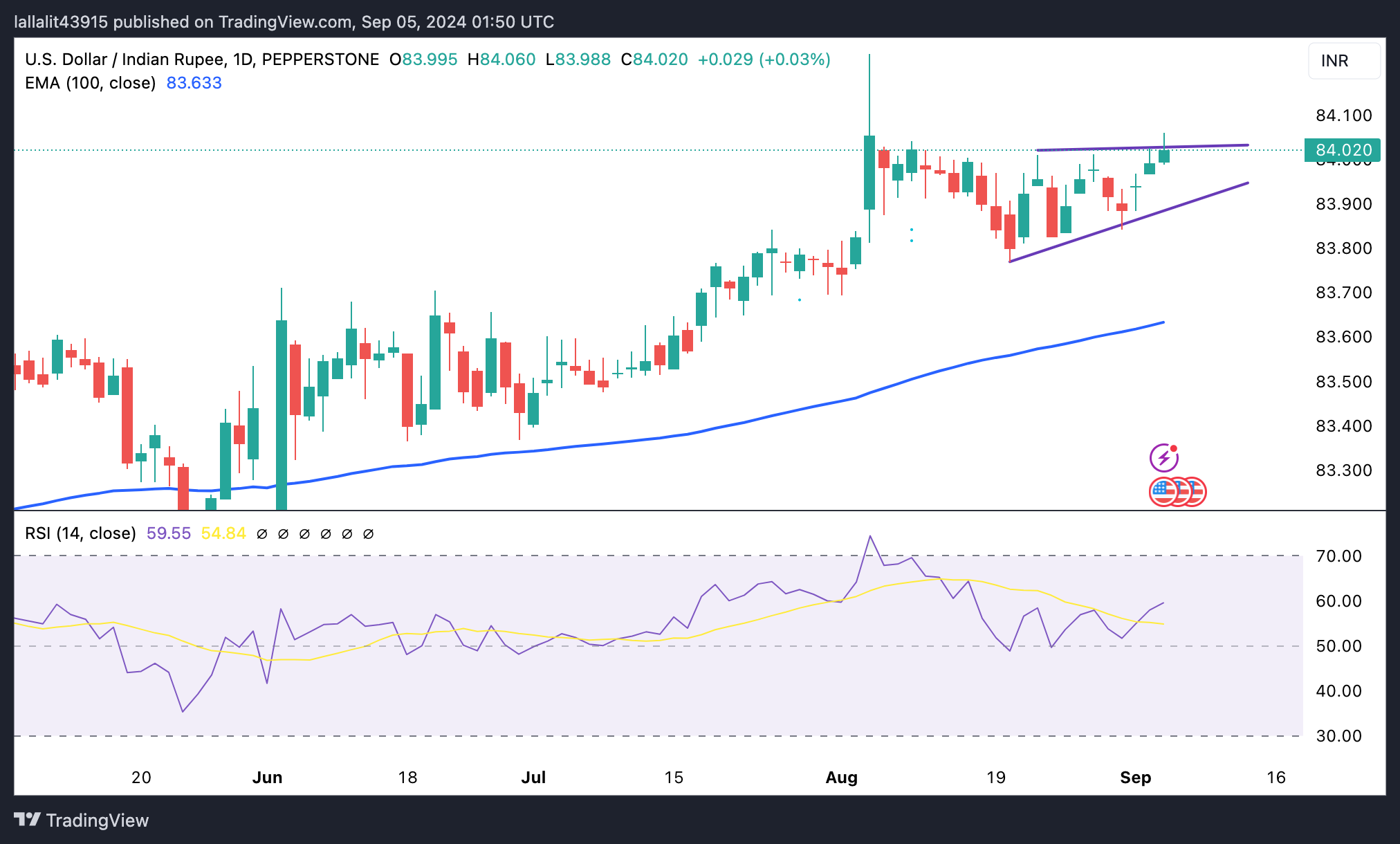- The Indian rupee weakened in early Asian trading on Thursday, pressured by a sell-off in Indian stocks.
- RBI intervention and falling crude oil prices could limit the INR’s fall.
- Investors are awaiting the US ISM Services PMI, due later on Thursday.
The Indian Rupee (INR) extends its decline on Thursday despite weakness in the US Dollar (USD). A sell-off in domestic stocks following global cues weighed on the INR, dragging the local currency to near record lows. However, possible intervention by the Reserve Bank of India (RBI) through USD selling could prevent the Indian Rupee from breaching the 84 mark. Also, a drop in crude oil prices could help limit INR losses as India is the world’s third-largest oil consuming and importing nation.
The US ISM Services Purchasing Managers’ Index (PMI) is due out later on Thursday, and is estimated to decline to 51.1 in August from 51.4 in July. On Friday, the focus will be on the US Non-Farm Payrolls (NFP) for August. This event could offer some signals about the size and pace of rate cuts by the Federal Reserve (Fed) this year.
Market Movers: Indian Rupee looks vulnerable ahead of US NFP data
- The HSBC India Services Purchasing Managers’ Index (PMI) improved to 60.9 in August from 60.3 in July, above the market consensus of 60.4. This figure was the highest since March.
- “The Indian rupee was once again stopped near 83.9750, its lowest close ever, possibly by the RBI as it sold dollars to ensure it remains within striking distance of the psychological level of 84.00. Risk-off sentiments ensured that markets kept buying dollars and the RBI kept supplying them,” said Anil Kumar Bhansali, head of treasury and managing director, Finrex Treasury Advisors LLP.
- The Labor Department’s Job Openings and Labor Turnover Survey showed available positions fell to 7.67 million in July, compared with 7.91 million openings (revised from 8.1 million) in June, the Labor Department reported Wednesday. That was below the market consensus of 8.1 million.
- Atlanta Fed President Raphael Bostic said Wednesday he is ready to begin cutting interest rates even though inflation is still above the U.S. central bank’s target.
- Markets now price in a nearly 57% chance of a 25 basis point (bps) rate cut by the Fed in September, while the odds of a 50 bps reduction stand at 43%, according to the CME’s FedWatch tool.
Technical Analysis: USD/INR Outlook Remains Positive
The Indian Rupee is weakening on the day. According to the daily chart, the USD/INR pair remains trapped within an ascending triangle. Nevertheless, the constructive view on the pair prevails as the price remains above the 100-day exponential moving average (EMA), with the 14-day Relative Strength Index (RSI) pointing higher above the midline near 59.55.
A major resistance level emerges in the 84.00-84.05 region, representing the psychological figure of 84.00, the upper boundary of the triangle and the high of September 4. Sustained trading above this level could lead USD/INR to 84.50.
On the downside, the ascending triangle support near 83.90 acts as an initial support level for the pair. A break of the mentioned level could revisit the 100-day EMA at 83.63.
Indian Rupee FAQs
The Indian Rupee (INR) is one of the most sensitive currencies to external factors. The price of crude oil (the country relies heavily on imported oil), the value of the US Dollar (most trade is done in US Dollars) and the level of foreign investment are all influential factors. Direct intervention by the Reserve Bank of India (RBI) in the foreign exchange markets to keep the exchange rate stable, as well as the level of interest rates set by the RBI, are other important factors that influence the Rupee.
The Reserve Bank of India (RBI) actively intervenes in the foreign exchange markets to maintain a stable exchange rate and help facilitate trade. In addition, the RBI attempts to keep the inflation rate at its 4% target by adjusting interest rates. Higher interest rates typically strengthen the Rupee. This is due to the role of the “carry trade,” where investors borrow from countries with lower interest rates to place their money in countries offering relatively higher interest rates and profit from the difference.
Macroeconomic factors that influence the value of the Rupee include inflation, interest rates, economic growth rate (GDP), trade balance, and foreign investment inflows. A higher growth rate can lead to higher overseas investment, increasing demand for the Rupee. A less negative trade balance will eventually lead to a stronger Rupee. Higher interest rates, especially real rates (interest rates minus inflation) are also positive for the Rupee. A risk-off environment can lead to higher foreign direct and indirect investment (FDI and FII) inflows, which also benefit the Rupee.
Higher inflation, particularly if it is comparatively higher than other countries, is generally negative for the currency as it reflects a devaluation through excess supply. Inflation also increases the cost of exports, leading to more rupees being sold to buy foreign imports, which is negative for the Indian Rupee. At the same time, higher inflation usually leads the Reserve Bank of India (RBI) to raise interest rates and this can be positive for the Rupee, due to increased demand from international investors. The opposite effect applies to lower inflation.
Source: Fx Street
I am Joshua Winder, a senior-level journalist and editor at World Stock Market. I specialize in covering news related to the stock market and economic trends. With more than 8 years of experience in this field, I have become an expert in financial reporting.








